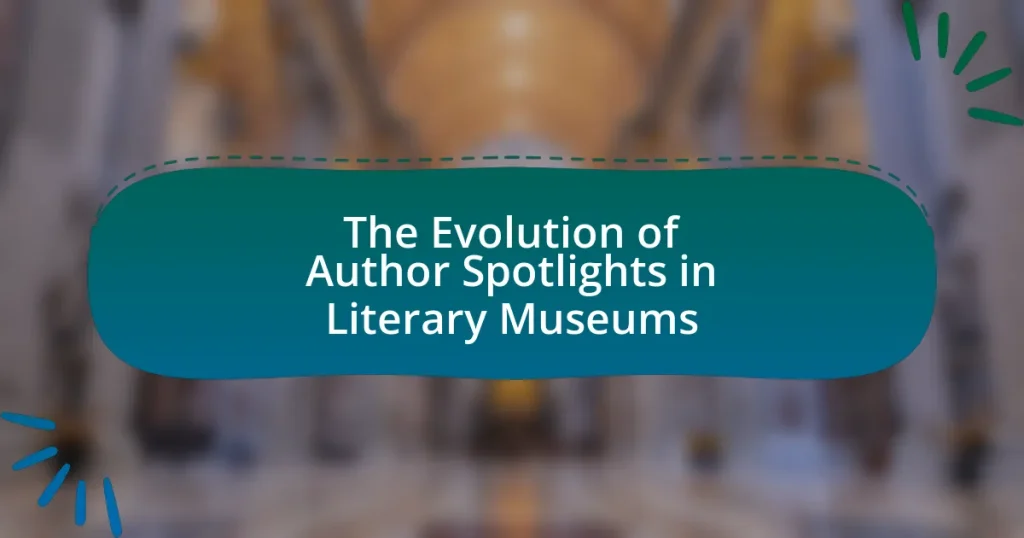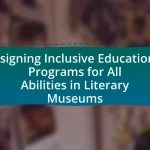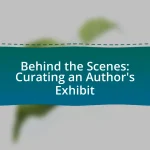Author Spotlights in Literary Museums are specialized exhibitions that highlight the works and lives of specific authors, enhancing visitor engagement through original manuscripts, personal artifacts, and multimedia presentations. The evolution of these spotlights reflects a shift from basic biographical displays to interactive experiences that incorporate technology and diverse literary voices. Historical factors, such as the rise of literary museums in the 19th century and changes in literary culture, have influenced their development. Author Spotlights play a crucial role in promoting literary heritage, fostering inclusivity, and addressing contemporary themes, while also facing challenges related to representation and budget constraints. Strategies for enhancing these exhibitions include collaboration with authors and literary communities, as well as targeted marketing efforts to attract a wider audience.
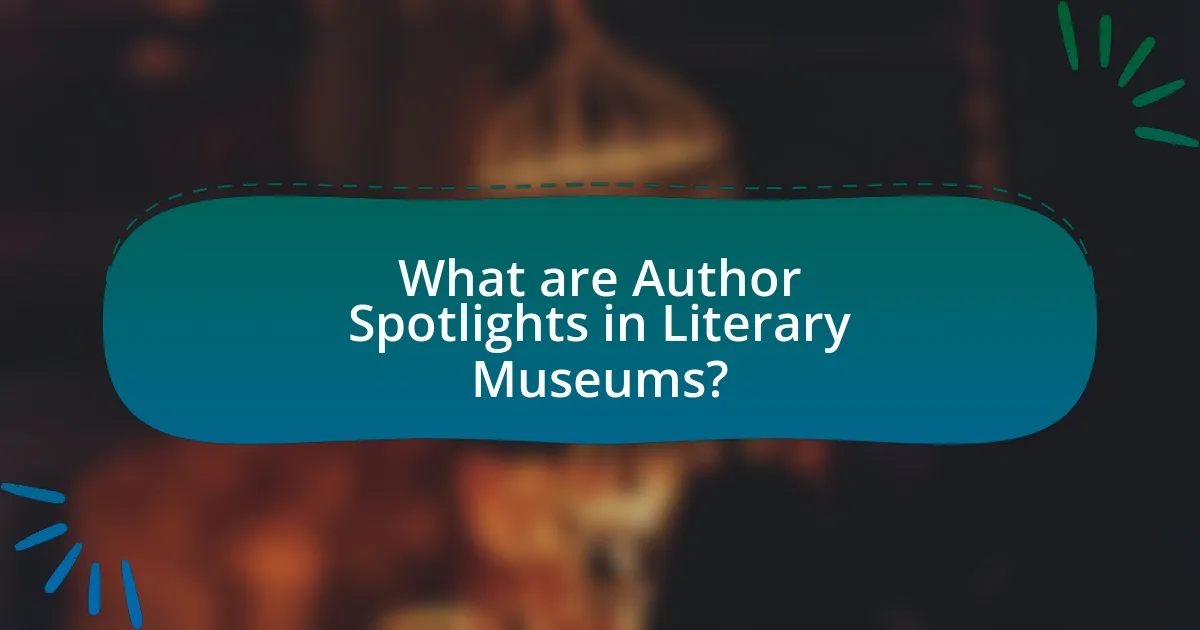
What are Author Spotlights in Literary Museums?
Author Spotlights in Literary Museums are dedicated exhibitions or displays that focus on the works, life, and contributions of specific authors. These spotlights aim to enhance visitor engagement by providing in-depth insights into an author’s literary significance, often featuring original manuscripts, personal artifacts, and multimedia presentations. For example, the British Library has hosted Author Spotlights that showcase the works of notable authors like Virginia Woolf, illustrating their impact on literature and culture.
How have Author Spotlights evolved over time?
Author Spotlights have evolved from simple biographical displays to multifaceted, interactive experiences that engage audiences in literary museums. Initially, these spotlights primarily featured basic information about authors, such as their birth dates and notable works. Over time, they have incorporated multimedia elements, including audio-visual presentations, digital archives, and interactive exhibits that allow visitors to explore an author’s life and impact more deeply. For instance, many modern Author Spotlights now utilize technology to create immersive environments, enabling visitors to experience the historical context of an author’s work. This evolution reflects a broader trend in museums towards enhancing visitor engagement and education through innovative storytelling techniques.
What historical factors influenced the development of Author Spotlights?
The development of Author Spotlights was influenced by the rise of literary museums in the 19th century, which aimed to celebrate authors and their contributions to literature. This period saw an increased interest in preserving literary heritage, driven by the Romantic movement that emphasized individual creativity and the importance of authors as cultural figures. Additionally, the establishment of dedicated literary spaces, such as the British Museum and the National Portrait Gallery, provided platforms for showcasing authors’ works and lives, further solidifying their significance in public consciousness. The combination of these cultural shifts and institutional support laid the groundwork for the modern concept of Author Spotlights in literary museums.
How have changes in literary culture impacted Author Spotlights?
Changes in literary culture have significantly impacted Author Spotlights by shifting the focus from traditional literary canon to diverse voices and contemporary themes. This evolution reflects a broader societal recognition of marginalized authors and genres, leading to a more inclusive representation in literary museums. For instance, the rise of digital platforms has allowed for greater accessibility and engagement with a wider audience, prompting museums to adapt their exhibits to highlight underrepresented authors and innovative storytelling methods. As a result, Author Spotlights now often feature interactive elements and multimedia presentations that resonate with modern audiences, showcasing the dynamic nature of literature today.
Why are Author Spotlights important in literary museums?
Author Spotlights are important in literary museums because they provide focused recognition of individual authors, enhancing visitor engagement and education. By showcasing an author’s life, works, and contributions, these spotlights create a deeper understanding of literary history and cultural context. For instance, the inclusion of personal artifacts, manuscripts, and multimedia presentations allows visitors to connect emotionally with the author’s journey, fostering a more immersive experience. This approach not only honors the authors but also promotes literacy and appreciation for literature among diverse audiences, as evidenced by increased visitor numbers and positive feedback in museums that implement such features.
What role do Author Spotlights play in promoting literary heritage?
Author Spotlights play a crucial role in promoting literary heritage by highlighting the contributions of specific authors to cultural and historical narratives. These focused presentations not only educate the public about an author’s life and works but also contextualize their significance within the broader literary landscape. For instance, literary museums often curate exhibitions that showcase an author’s manuscripts, personal artifacts, and critical analyses, thereby preserving and celebrating their legacy. This approach fosters a deeper appreciation for literary history and encourages engagement with the texts, ensuring that the authors’ influences are recognized and remembered across generations.
How do Author Spotlights enhance visitor engagement and education?
Author Spotlights enhance visitor engagement and education by providing focused insights into an author’s life and work, which fosters a deeper connection with the audience. These spotlights often include interactive displays, multimedia presentations, and curated artifacts that allow visitors to explore the author’s contributions in a dynamic way. For instance, literary museums that feature Author Spotlights report increased visitor interaction and satisfaction, as evidenced by studies showing that personalized experiences lead to higher retention of information and greater emotional investment in the subject matter. This approach not only educates visitors about the author’s significance but also encourages them to engage with literature on a more personal level, ultimately enriching their overall experience.
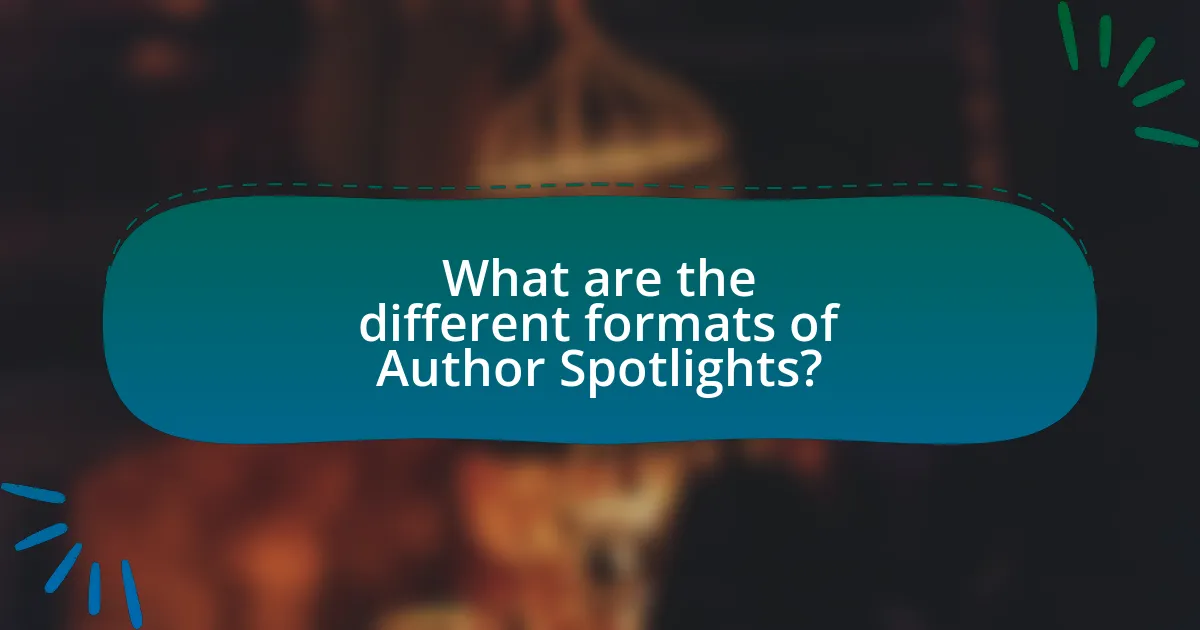
What are the different formats of Author Spotlights?
Author Spotlights can take various formats, including written profiles, video interviews, podcasts, and interactive exhibits. Written profiles typically provide biographical information and insights into an author’s work, while video interviews allow for a more personal connection through visual storytelling. Podcasts offer an auditory experience, often featuring discussions about the author’s themes and influences. Interactive exhibits engage visitors through multimedia presentations, allowing them to explore an author’s contributions in a dynamic way. Each format serves to enhance the audience’s understanding and appreciation of the author’s literary impact.
How do exhibitions and displays vary in Author Spotlights?
Exhibitions and displays in Author Spotlights vary significantly based on the author’s genre, historical context, and the intended audience. For instance, a spotlight on a contemporary author may utilize interactive digital displays to engage younger audiences, while a focus on a classic author might feature traditional artifacts such as handwritten manuscripts or first editions to emphasize historical significance. Additionally, thematic elements can differ; some exhibitions may center around specific works or literary movements, while others might explore the author’s personal life and influences, showcasing personal letters or photographs. This variation reflects the diverse approaches museums take to present literary figures, aiming to create a unique experience that resonates with visitors and highlights the author’s impact on literature.
What types of artifacts are commonly featured in Author Spotlights?
Author Spotlights commonly feature artifacts such as manuscripts, letters, photographs, and personal belongings of the authors. These artifacts provide insight into the authors’ lives and creative processes, enhancing the visitor’s understanding of their literary contributions. For example, original manuscripts allow audiences to see the author’s writing style and revisions, while personal letters can reveal their thoughts and relationships. Such artifacts are essential in creating a more immersive experience in literary museums, showcasing the historical context and significance of the authors’ works.
How do digital technologies influence the presentation of Author Spotlights?
Digital technologies significantly enhance the presentation of Author Spotlights by enabling interactive and multimedia experiences. These technologies allow literary museums to incorporate videos, audio recordings, and virtual reality elements, which engage visitors more deeply than traditional static displays. For instance, the use of augmented reality can bring an author’s works to life, allowing visitors to experience scenes from their books in an immersive way. Additionally, digital platforms facilitate broader access to Author Spotlights, reaching global audiences through online exhibitions and social media campaigns. This shift not only modernizes the presentation but also democratizes access to literary heritage, as evidenced by initiatives like the British Library’s digital collections, which have increased visitor engagement by over 30% since their launch.
What are the challenges faced in creating Author Spotlights?
Creating Author Spotlights presents several challenges, including the need for accurate representation of the author’s work and life, which requires extensive research and verification of facts. Additionally, curators must balance the artistic interpretation of the author’s contributions with factual accuracy, ensuring that the spotlight resonates with diverse audiences while remaining true to the author’s intent. Limited resources, such as budget constraints and time limitations, further complicate the process, often restricting the depth of content that can be included. Furthermore, engaging storytelling that captures the essence of the author while avoiding oversimplification or bias is a significant hurdle. These challenges highlight the complexity of effectively showcasing an author’s legacy within literary museums.
How do budget constraints affect the development of Author Spotlights?
Budget constraints significantly limit the development of Author Spotlights by restricting the resources available for research, design, and implementation. When financial resources are tight, literary museums may prioritize essential operations over innovative projects, leading to fewer or less comprehensive Author Spotlights. For instance, a study by the American Alliance of Museums indicates that 60% of museums report budget limitations as a primary barrier to expanding their exhibitions and programs. This financial pressure can result in reduced staff hours, limited marketing efforts, and a reliance on volunteer contributions, ultimately diminishing the quality and reach of Author Spotlights.
What issues arise in curating diverse literary voices in Author Spotlights?
Curating diverse literary voices in Author Spotlights presents challenges such as representation imbalance, cultural appropriation, and accessibility. Representation imbalance occurs when certain voices dominate the spotlight, leading to a lack of visibility for marginalized authors. Cultural appropriation can arise when curators highlight voices from cultures they do not belong to, potentially misrepresenting those narratives. Accessibility issues may stem from language barriers or the physical location of literary museums, which can limit engagement from diverse audiences. These challenges necessitate careful consideration and intentional strategies to ensure a truly inclusive representation of literary voices.
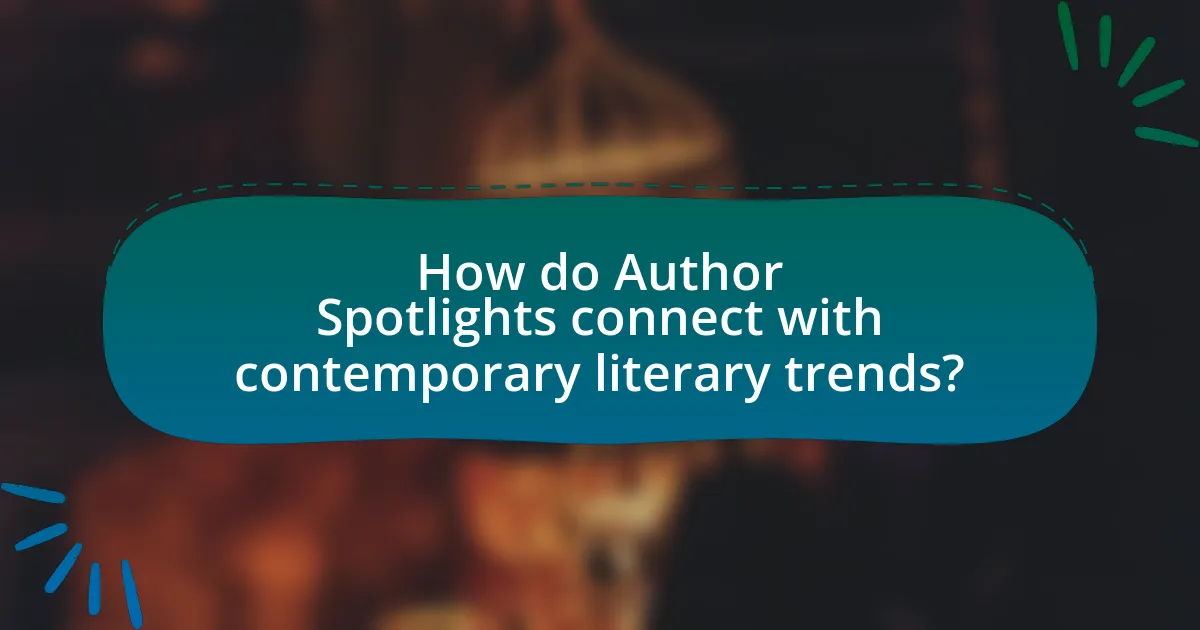
How do Author Spotlights connect with contemporary literary trends?
Author Spotlights connect with contemporary literary trends by showcasing diverse voices and innovative storytelling techniques that reflect current societal issues. These spotlights often highlight authors who engage with themes such as identity, social justice, and technology, aligning with the growing reader interest in authenticity and representation. For instance, literary museums increasingly feature authors from underrepresented backgrounds, which mirrors the broader trend in publishing towards inclusivity and varied narratives. This connection is evident in initiatives like the National Book Foundation’s focus on promoting diverse authors, which has gained traction in recent years, emphasizing the importance of these trends in shaping literary discourse.
What current themes are reflected in modern Author Spotlights?
Current themes reflected in modern Author Spotlights include diversity, intersectionality, and the exploration of contemporary social issues. These themes highlight the importance of representing a wide range of voices and experiences in literature, showcasing authors from various backgrounds and cultures. For instance, many literary museums now feature spotlights on authors who address topics such as racial identity, gender equality, and environmental concerns, thereby engaging audiences with relevant societal discussions. This shift aligns with broader cultural movements advocating for inclusivity and representation in the arts, emphasizing the role of literature in reflecting and shaping societal values.
How do Author Spotlights address issues of representation and inclusivity?
Author Spotlights address issues of representation and inclusivity by showcasing diverse authors and their works, thereby amplifying underrepresented voices in literature. These initiatives often highlight authors from various backgrounds, including different ethnicities, genders, and socio-economic statuses, which helps to create a more comprehensive literary narrative. For instance, literary museums may feature exhibitions that focus on the contributions of marginalized authors, thus educating the public about their significance and fostering a more inclusive literary culture. This approach not only enriches the understanding of literature but also encourages readers to engage with a wider array of perspectives, ultimately promoting inclusivity within the literary community.
What impact do social media and online platforms have on Author Spotlights?
Social media and online platforms significantly enhance Author Spotlights by increasing visibility and engagement with audiences. These platforms allow authors to share their work, interact with readers, and promote events, leading to a broader reach than traditional methods. For instance, a study by the Pew Research Center found that 69% of adults in the U.S. use social media, providing authors with a vast audience to connect with. Additionally, online platforms enable real-time feedback and community building, fostering a more interactive experience for readers and authors alike. This shift has transformed Author Spotlights from static presentations into dynamic, participatory events that can adapt to audience interests and trends.
What best practices can be applied to enhance Author Spotlights?
To enhance Author Spotlights, museums should focus on interactive storytelling, personalized experiences, and multimedia integration. Interactive storytelling engages visitors by allowing them to explore an author’s life and works through immersive exhibits, which can increase visitor retention and satisfaction. Personalized experiences, such as tailored tours or workshops based on visitor interests, foster a deeper connection with the author’s legacy. Multimedia integration, including videos, audio recordings, and digital displays, can present information in diverse formats, catering to different learning styles and enhancing overall engagement. These practices have been shown to improve visitor experiences in cultural institutions, as evidenced by studies indicating that interactive and multimedia elements significantly boost visitor interaction and learning outcomes.
How can collaboration with authors and literary communities improve Author Spotlights?
Collaboration with authors and literary communities can significantly enhance Author Spotlights by fostering diverse perspectives and enriching content. When authors engage with literary communities, they can share unique insights and experiences that resonate with audiences, making the spotlights more relatable and engaging. For instance, collaborative events such as panel discussions or workshops can draw larger audiences, as seen in the success of literary festivals where multiple authors participate, leading to increased visibility and interest in individual authors. Additionally, partnerships with literary communities can provide access to resources and networks that amplify promotional efforts, as evidenced by the rise in social media campaigns that feature collaborative author spotlights, resulting in higher engagement rates.
What strategies can be employed to attract a wider audience to Author Spotlights?
To attract a wider audience to Author Spotlights, literary museums can implement targeted marketing campaigns that utilize social media platforms, email newsletters, and collaborations with local schools and libraries. These strategies increase visibility and engagement by reaching diverse demographics. For instance, a study by the Pew Research Center indicates that 72% of adults use social media, making it an effective channel for promoting events and features related to Author Spotlights. Additionally, partnerships with educational institutions can foster community involvement and attract younger audiences, as evidenced by successful outreach programs that have increased attendance by up to 30% in similar cultural institutions.
